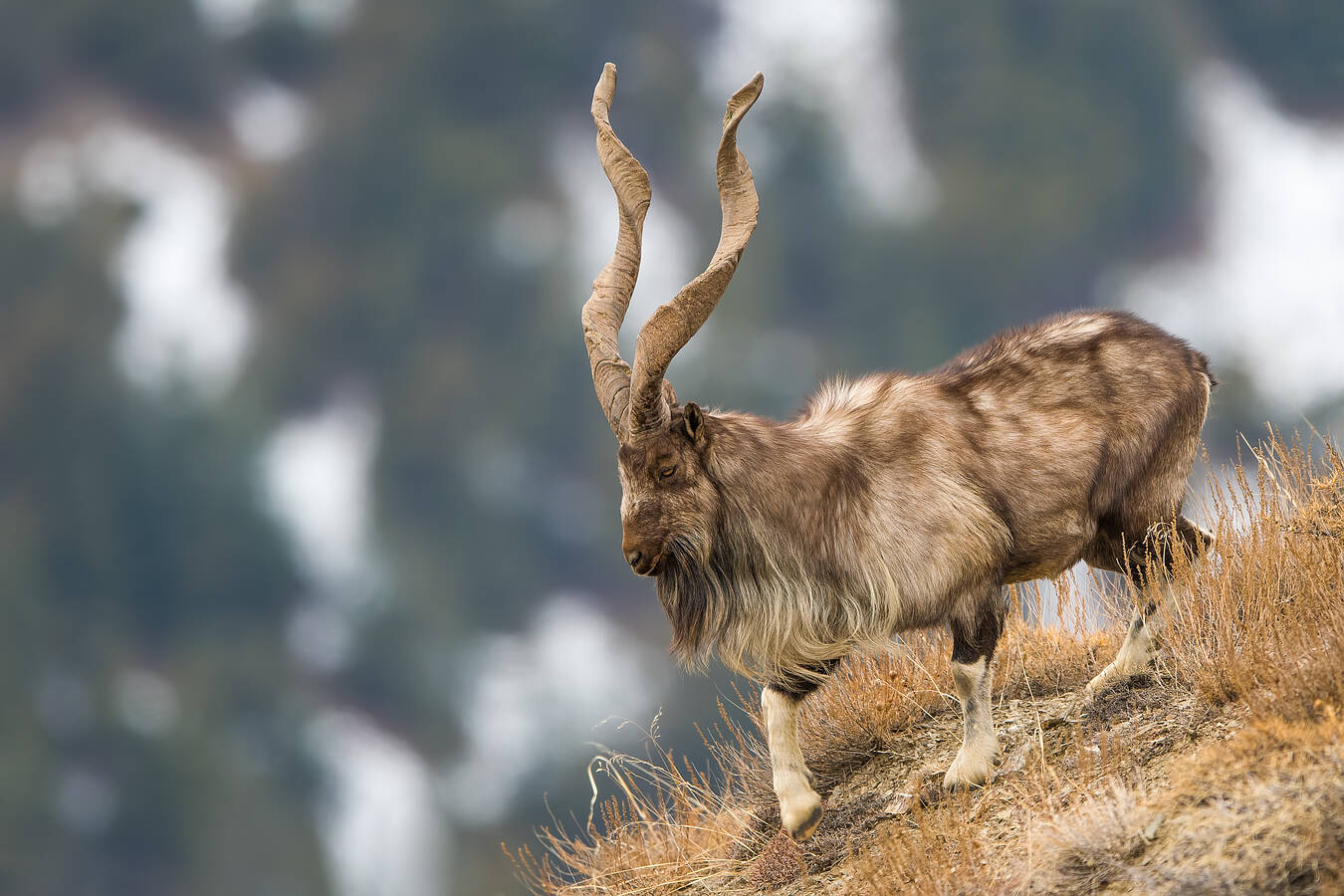
Pakistan: A Wildlife Haven - 10 of the Cutest Animals You'll Find
Pakistan, a land of breathtaking landscapes and rich cultural heritage, is also a treasure trove of incredible biodiversity. From the majestic peaks of the Himalayas to the vast plains of the Indus River, this diverse nation is home to a captivating array of wildlife. In this blog post, we'll embark on a delightful journey to discover 10 of the cutest animals you might encounter in this fascinating country.
1. The Markhor: A Majestic Mountain Goat
The Markhor, Pakistan's national animal, is a truly remarkable creature. This wild goat, known for its impressive spiral horns that resemble a corkscrew, inhabits the rugged mountain ranges of the country. With its long, flowing coat and agile movements, the Markhor is a sight to behold.
Unique Features: The Markhor's most striking feature is undoubtedly its impressive set of horns. These horns can grow up to 60 inches long in males and are used for defense, display, and territorial marking.
Habitat: These magnificent creatures are primarily found in the high-altitude regions of the Himalayas, Hindu Kush, and Karakoram ranges.
Conservation Status: Sadly, the Markhor is classified as "Near Threatened" due to habitat loss, poaching, and illegal hunting. Conservation efforts are underway to protect this iconic species.
2. The Snow Leopard: A Ghost of the Mountains
The elusive Snow Leopard, a creature of legend, is a true marvel of nature. This magnificent feline, with its thick, white fur and mesmerizing green eyes, is perfectly adapted to the harsh conditions of the high-altitude mountains.
Unique Features: The Snow Leopard's thick, dense fur provides excellent insulation against the frigid mountain temperatures. Its large paws act like snowshoes, allowing it to move effortlessly across the snow-covered terrain.
Habitat: This elusive cat inhabits the remote and rugged mountain ranges of the Himalayas and Karakoram, where it blends seamlessly with the snowy landscape.
Conservation Status: The Snow Leopard is classified as "Vulnerable" due to threats such as poaching, habitat loss, and prey depletion. Conservation efforts are crucial to ensure the survival of this magnificent creature.
3. The Red Panda: A Fuzzy Friend from the Himalayas
The Red Panda, a close relative of the raccoon, is a captivating creature with a unique appearance. This adorable animal, with its reddish-brown fur, ringed tail, and mask-like markings, is a true delight to behold.
Unique Features: The Red Panda has a remarkable adaptation: a "pseudo-thumb" that helps it grasp bamboo, its primary food source.
Habitat: These enchanting creatures are primarily found in the temperate forests of the Himalayas, including areas within Pakistan.
Conservation Status: The Red Panda is classified as "Endangered" due to habitat loss, poaching, and the illegal pet trade. Conservation efforts are crucial to protect this unique and beloved species.
4. The Indus River Dolphin: A Rare Aquatic Gem
The Indus River Dolphin, a unique and critically endangered species, is a true marvel of evolution. This freshwater dolphin, adapted to the murky waters of the Indus River, is a testament to the remarkable adaptability of life.
Unique Features: The Indus River Dolphin has evolved unique adaptations to its challenging environment, including a long, slender beak and sensitive whiskers that help it navigate the murky waters.
Habitat: This rare dolphin is primarily found in the Indus River system, including areas within Pakistan.
Conservation Status: The Indus River Dolphin is critically endangered due to habitat loss, water pollution, and human disturbance. Conservation efforts are crucial to prevent the extinction of this unique and fascinating creature.
5. The Himalayan Brown Bear: A Majestic Giant
The Himalayan Brown Bear, a powerful and impressive animal, is a true giant of the mountain forests. This large bear, with its thick brown fur and powerful build, is a force to be reckoned with.
Unique Features: The Himalayan Brown Bear is highly adaptable and can be found in a variety of habitats, from dense forests to alpine meadows.
Habitat: These majestic bears inhabit the forested areas of the Himalayas, including parts of northern Pakistan.
Conservation Status: The Himalayan Brown Bear is classified as "Vulnerable" due to habitat loss, human-wildlife conflict, and the illegal trade in bear parts.
6. The Golden Eagle: A Bird of Prey
The Golden Eagle, a magnificent bird of prey, is a symbol of power and freedom. This majestic raptor, with its golden-brown plumage and piercing yellow eyes, is a true predator of the skies.
Unique Features: The Golden Eagle is renowned for its exceptional hunting skills. It possesses incredible strength and agility, allowing it to capture prey as large as foxes and wolves.
Habitat: These magnificent birds can be found in a variety of habitats across Pakistan, including mountains, deserts, and grasslands.
Conservation Status: While the Golden Eagle is not currently considered threatened, habitat loss and human disturbance pose potential threats to its populations.
7. The Chinkara: The Indian Gazelle
The Chinkara, also known as the Indian Gazelle, is a graceful and elegant antelope. This small antelope, with its sandy-brown coat and distinctive black eye patches, is a common sight in the arid regions of Pakistan.
Unique Features: The Chinkara is known for its incredible jumping abilities, allowing it to leap over fences and obstacles with ease.
Habitat: These agile creatures are primarily found in arid and semi-arid regions, including deserts, grasslands, and scrublands.
Conservation Status: While the Chinkara is not currently considered threatened, habitat loss and hunting pressure pose potential threats to its populations.
8. The Urial: A Wild Sheep
The Urial, a wild sheep with a distinctive white rump patch, is a remarkable sight to behold. This hardy species is well-adapted to the harsh conditions of the arid and mountainous regions of Pakistan.
Unique Features: The Urial is known for its impressive horns, which are curved and can grow up to 30 inches long in males.
Habitat: These wild sheep inhabit the arid and mountainous regions of Pakistan, including rocky hills, plateaus, and desert margins.
Conservation Status: The Urial is currently classified as "Least Concern" by the IUCN, but habitat loss and hunting pressure pose potential threats to its populations.
9. The Desert Fox: A Master of Camouflage
The Desert Fox, also known as the Fennec Fox, is a truly adorable creature. This small fox, with its large ears, creamy-white fur, and black-tipped tail, is perfectly adapted to the harsh desert environment.
Unique Features: The Desert Fox's large ears help to dissipate heat and aid in hearing prey moving underground.
Habitat: These enchanting creatures are primarily found in the arid desert regions of Pakistan.
Conservation Status: The Desert Fox is not currently considered threatened, but habitat loss and human disturbance pose potential threats to its populations.
10. The Houbara Bustard: A Majestic Bird
The Houbara Bustard, a large and majestic bird, is a true spectacle to behold. This ground-dwelling bird, with its long neck, powerful legs, and distinctive black and white plumage, is a prized game bird in some parts of the world.
Unique Features: The Houbara Bustard is known for its impressive courtship displays, which include elaborate bowings and strutting.
Habitat: These magnificent birds are primarily found in arid and semi-arid regions, including deserts and grasslands.
Conservation Status: The Houbara Bustard is classified as "Vulnerable" due to habitat loss, hunting pressure, and illegal trade.
Conclusion
Pakistan, with its diverse landscapes and rich biodiversity, is a true wildlife haven. From the majestic mountains to the vast deserts, this incredible country is home to a captivating array of animals, each with its own unique charm and significance.
By raising awareness about these incredible creatures and supporting conservation efforts, we can ensure that future generations will have the opportunity to experience the wonders of Pakistani wildlife.
Call to Action:
Visit a wildlife sanctuary: Experience the beauty of Pakistani wildlife firsthand by visiting a local wildlife sanctuary or national park.
Support conservation organizations: Donate to or volunteer with organizations working to protect Pakistan's endangered species.
Spread the word: Share this blog post with your friends and family to raise awareness about the incredible wildlife of Pakistan.
By working together, we can ensure that the diverse and captivating wildlife of Pakistan thrives for generations to come.
